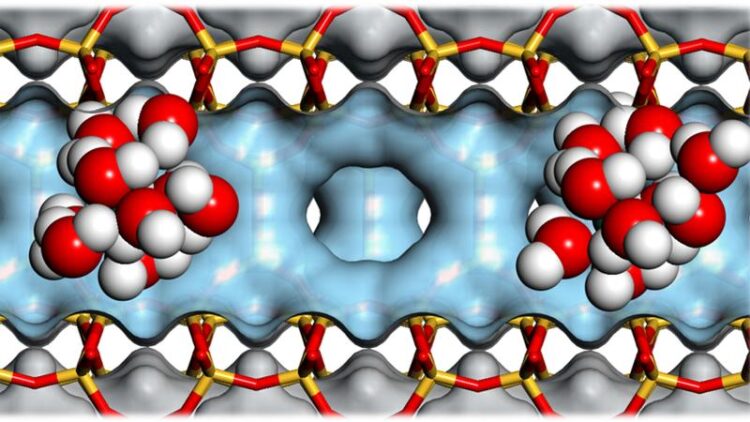Catalyzing the conversion of biomass to biofuel

Cluster von Wassermolekülen in den Poren eines Zeoltihen.
Andreas Jentys / TUM
Water in zeolites saves energy in the conversion of biomass into biofuel.
Zeolites are extremely porous materials: Ten grams can have an internal surface area the size of a soccer field. Their cavities make them useful in catalyzing chemical reactions and thus saving energy. An international research team has now made new findings regarding the role of water molecules in these processes. One important application is the conversion of biomass into biofuel.
Fuel made from biomass is considered to be climate-neutral, although energy is still needed to produce it: The desired chemical reactions require high levels of temperature and pressure.
“If we are to do without fossil energy sources in the future and make efficient large-scale use of biomass, we will also have to find ways to reduce the energy required for processing the biomass,” says Johannes Lercher, professor for Chemical Technology at the Technical University of Munich (TUM) and Director of the Institute for Integrated Catalysis at the Pacific Northwest National Laboratory in Richland, Washington (USA).
Working together with an international research team, Lercher has taken a closer look at the role of water molecules in reactions inside the zeolite’s pores, which are less than one nanometer in size.
It all starts with acids
One characteristic of an acid is that it easily donates protons. Thus, when added to water, hydrochloric acid splits into negatively charged chloride anions, like those found in table salt crystals, and positively charged protons which attach themselves to the water molecules. This results in a positively charged hydronium ion, which looks to further pass on this proton, for example to an organic molecule.
When the organic molecule is “forced” to accept a proton, it tries to stabilize itself. Thus, an alcohol can give rise to a molecule with a double bond – a typical reaction step on the path from biomass to biofuel. The zeolite walls stabilize transitional states occurring during conversion and, thus, help to minimize the amount of energy required by the reaction to occur.
Zeolites acting as acids
Zeolites contain oxygen atoms in their crystal structure which already carry a proton. Like molecular acids they form hydronium ions through the interactions with water.
However, while hydronium ions disperse in water, they remain closely associated with the zeolite. Chemical pre-treatment can vary the number of these active centers and, thus, establish a certain density of hydronium ions in the pores of the zeolite.
The ideal zeolite for every reaction
By systematically varying the size of the cavities, the density of the active sites and the amount of water, the research team was able to elucidate the pore sizes and concentrations of water which best catalyzed selected example reactions.
“In general, it’s possible to increase the reaction rate by making the pores smaller and raising the charge density,” Johannes Lercher explains. “However, this increase has its limits: When things get too crowded and the charges are too close to one another, the reaction rate drops again. This makes it possible to find the optimum conditions for every reaction.”
“Zeolites are generally suitable as nanoreactors for all chemical reactions whose reaction partners fit into the pores and in which an acid is used as a catalyst,” emphasizes Lercher. “We are at the very beginning of a development with the potential to increase the reactivity of molecules even at low temperatures and, thus, to save considerable amounts of energy in the production of fuels or chemicals.”
Participants in the research included the Catalysis Research Center at the Technical University of Munich, the US Institute for Integrated Catalysis at the Pacific Northwest National Laboratory, the Swiss Paul Scherrer Institute as well as the University of Yangzhou and the Qingdao Institute of Bioenergy and Bioprocess Technology in China. The work was funded by the Technical University of Munich (TUM) and the US Department of Energy, Office of Science.
Wissenschaftliche Ansprechpartner:
Prof. Dr. Johannes A. Lercher
Professorship of Chemical Technology and
Catalysis Research Center
Technical University of Munich
Lichtenbergstr. 4, 85748 Garching, Germany
Tel.: +49 89 289 13540 – E-Mail: johannes.lercher@ch.tum.de
Originalpublikation:
Niklas Pfriem, Peter H. Hintermeier, Sebastian Eckstein, Sungmin Kim, Qiang Liu, Hui Shi, Lara Milakovic, Yuanshuai Liu, Gary L. Haller, Eszter Baráth, Yue Liu, Johannes A. Lercher
Role of the ionic environment in enhancing the activity of reacting molecules in zeolite pores
Science, May 28, 2021: Vol. 372, Issue 6545, pp. 952-957 – DOI: 10.1126/science.abh3418
Weitere Informationen:
https://science.sciencemag.org/content/372/6545/952.abstract Original publication
https://www.tum.de/nc/en/about-tum/news/press-releases/details/36775/ Press release on the TUM website
https://www.department.ch.tum.de/tc2/ Website of Prof. Lercher’s research group
Media Contact
All latest news from the category: Life Sciences and Chemistry
Articles and reports from the Life Sciences and chemistry area deal with applied and basic research into modern biology, chemistry and human medicine.
Valuable information can be found on a range of life sciences fields including bacteriology, biochemistry, bionics, bioinformatics, biophysics, biotechnology, genetics, geobotany, human biology, marine biology, microbiology, molecular biology, cellular biology, zoology, bioinorganic chemistry, microchemistry and environmental chemistry.
Newest articles

Innovative 3D printed scaffolds offer new hope for bone healing
Researchers at the Institute for Bioengineering of Catalonia have developed novel 3D printed PLA-CaP scaffolds that promote blood vessel formation, ensuring better healing and regeneration of bone tissue. Bone is…

The surprising role of gut infection in Alzheimer’s disease
ASU- and Banner Alzheimer’s Institute-led study implicates link between a common virus and the disease, which travels from the gut to the brain and may be a target for antiviral…

Molecular gardening: New enzymes discovered for protein modification pruning
How deubiquitinases USP53 and USP54 cleave long polyubiquitin chains and how the former is linked to liver disease in children. Deubiquitinases (DUBs) are enzymes used by cells to trim protein…



